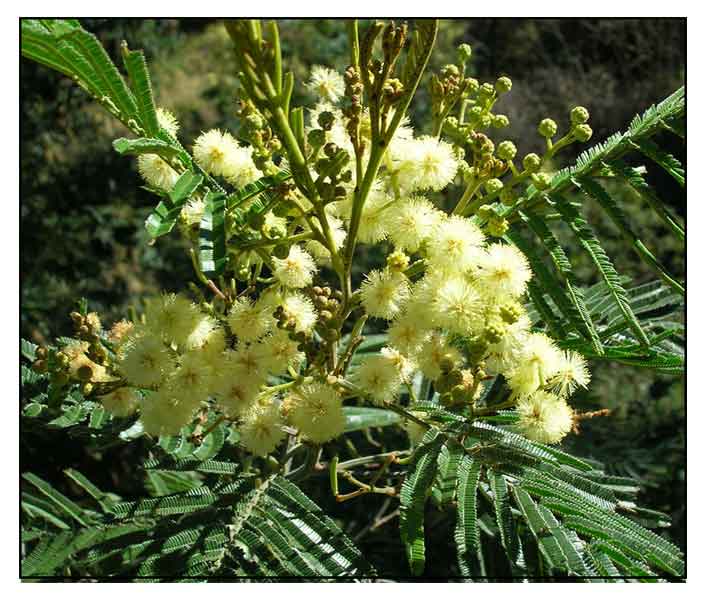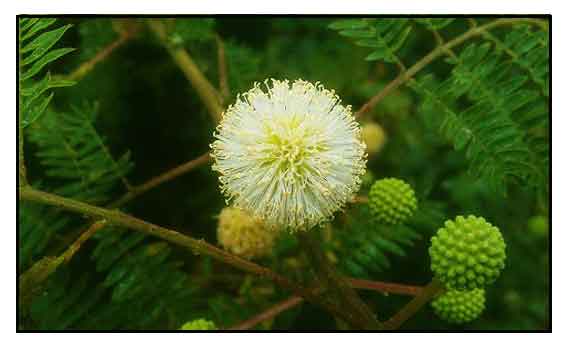 Gen info Gen info
- Acacia mearnsii De Wild. was first described by Belgian naturalist Emile Auguste Joseph De Wildeman in 1925. (5)
- The species is named after American naturalist Edgar Alexander Mearns, who collected the type from a cultivated specimen in East Africa.
- The genus Acacia contains over 1000 species, just behind the largest genus in the Fabaceae family, Astragalus with over 3000 species. (5)
- While it is an important plantation species for tannin production and woodchip exports (Brazil and South Africa), in many countries it is an invasive species partly due to its ability to produce large amounts of long-live seeds. Seed may remain viable for up to 50 years. It may replace grass communities, increase rainfall interception and transpiration, causing soil to dessicate more quickly. It can destabilize stream banks and support a lower diversity of species. (Adair, 2002; Sankaran, 2002; Le Maitre et al. 1999; Samways et al 1996). (3) (6)
- The current total planted black wattle area is 110,000 ha in South Africa and about 170,000 ha in Brazil. Because of the commerce of wattle woodchips in the international market, it is a profitable crop in South Africa, with timber providing 85% of revenue and bark the other 15%.
 Botany Botany
Acacia mearnsii is a small to large, unarmed evergreen tree, single-stemmed or multi-branched, with a low, rounded, and spreading crown, growing 6 to 15 meters tall, occasionally to a height of 25 meters. Bole is usually straight, 10 to 15 centimeters, occasionally up to 50 centimeters, in diameter. Branchlets are shallowly ridged, with all parts finely hairy. Leaves are dark-green finely hairy, bipinnate. Leaflets are short, 1.5 to 4 millimeters, crowded, with raised glands at and between junctions of pinnae hair. Flowers are pale yellow or cream, with globular flower heads in large, fragrant sprays. Fruits are dark brown pods, finely hairy and markedly constricted. (Henderson, 1995; PIER, 2010; de Wit, Crookes and van Wilgen, 2001).(1)
Distribution
- Introduced.
- Grown for shade and shelter of plantation crops.
- An understorey tree of tall open forests, in fringes of closed forests or in dense thickets on recolonized lands. (1)
Constituents
- The bark of Acacia mearnsii contains significant amounts of water-soluble components called "wattle tannin." (4)
- Wattle tannins are composed of polyflavanoids and their precursors, together with other phenolic components and complex mixtures of carbohydrate gums, sugars and amino acids
(5)
- Study of wattle tannin from A. mearnsii bark isolated and identified three dimeric proanthocyanidins: robinetinidol-(4α-8)-catechin, fisetinidol-(4β-8)-catechin and robinetinidol-(4β-8)-catechin. (5)
- Monomeric flavonoid compounds from A. mearnsii bark wattle tannin contains leucofisetinidin, leucorobinetinidin, quercetin, myricetin, butin, butein, robtein, fisetinidol, robinetinidol, catechin, gallocatechin, fustin, dihydrorobinetin, fisetin and robinetin.
(5)
- A total of 90.6% of tannin extract was found to be proanthocyanidins, in which the compositions of dimers, trimers, and tetramers were 42%, 40%, and 8.6%, respectively.
(6)
- Phytochemical studies of leaves have yielded saponins, flavonoids, and tannins.
(9)
- GC-MS study of A. mearnsii for volatile oils yielded 20, 38,
21, and 38 components accounting for 93.8%, 92.1%, 78.5% and 90.9% of total oils of fresh, dry leaves, and fresh and dry stem bark, respectively. Major components of oil were octadecyl alcohol (25.5%) and phytol (10.5%); cis-verbenol (29.5%); phytol (10.1%) and phytol (23.4%) for fresh leaves, dried leaves, and fresh stem, dry stem bark, respectively. (see study below)
(14)
Properties
-
Considered astringent, antimicrobial, styptic.
- Studies have shown antioxidant, anti-inflammatory, antitumor, antibacterial, antifungal , anti-itch properties.
Parts used
Bark, leaves.
Uses
Folkloric
- No reported folkloric medicinal use in the Philippines.
- Tannin-rich bark can be used as astringent for treatment of diarrhea and dysentery., or applied externally for treatment of wounds, hemorrhoids, or used as mouthwash. (1)
- In South Africa, used for treatment of microbial infections. (2) Bark, ground and mixed with water, drunk as decoction for treatment of stomachache and diarrhea. (13)
- Leaves used for wound healing.
- The aboriginal Ngunnawal people of the Australian Capital Territory use a bark infusion to treat indigestion. (16)
Others
- Agri: Primary source of tannins. Use as soil conditioner and stabilizer and for restoring native woodlands. (1)
- Tannin: Wattle bark is most widely used tannin material in the world. Yielded 30-45% (dry basis) high quality tannin. Powdered bark is source of tannin formaldehyde adhesives for exterior grade plywood, particle board and laminated timber. (1) Tannin compounds extracted from the bark used in the production of soft leather. (3) World demand for vegetable tannins have remained unchanged in the past two decades due to competition from synthetic tannins. South Africa produces 45,000 t of bark extract annually, while Brazil produces 30,000-40,000 t, with annual value of both about US$ 100 million. (7)
- Timber: Used as building material; charcoal as fuel; pulp and wood chips used to produce paper. (3) Significant secondary products are charcoal and firewood. (7)
- Dietary supplement: Following discovery of its strong antioxidant activity, a wattle tannin dietary supplement has been developed. (5)
- Woodchips commerce: The current total planted black wattle area is 110,000 ha in South Africa and about 170,000 ha in Brazil. Because of the commerce of wattle woodchips in the international market, it is a profitable crop in South Africa, with timber providing 85% of revenue and bark the other 15%. (7)
 Studies Studies
• Antimicrobial / Nontoxic: Study evaluated crude acetone extracts for antimicrobial activity using both agar diffusion and macrobroth dilution methods and cytotoxicity effect with brine shrimp lethality assay. Results showed inhibition of both bacterial and fungal isolates, with bacteria showing more susceptibility than fungi, and was more bactericidal (75%) than bacteriostatic (25%) and more fungicidal (66.67%) than fungistatic (33.33%). On brine shrimp lethality assay, the extract was nontoxic with LC50 >100 µg/mL. (2)
• Tannins / Biologic Activities: This study reports on a review of literature relating to the biologic activities of tannins from A. mearnsii bark. The discovery of bark tannin's strong antioxidant activity led to the development of a wattle tannin dietary supplement. Tannins consist mostly of polyflavanoids. Antioxidant activities of tannin relating to anti-tumor properties, viability of human neuroblastoma SH-SY5Y cells and anti-hypertensive effects have been studied. Antioxidant activity of proanthocyanidins was found higher than flavan-3-ol monomers. On antimicrobial studies, bacteria were found more susceptible than fungal strains. Extracts of bark inhibit the growth of cyanobacteria Based on studies, the Acacia bark extract may inhibit not only growth of typical intestinal bacteria but also the growth of intestinal bacteria such as Clostridium and Bacteroides. This suggests potential as dietary supplement to control the human intestinal microbiome. (5)
• Antioxidant / Anti-Tumor Activity / Tannin: The antioxidant activity of wattle tannin from A. mearnsii bark was first discovered in 2001 and reported in a patent publication in 2004.In 2007, Liu reported the relationship between antioxidant activity of a bark extract and anti-tumor activity. Proanthocyanidins crude products from the extract showed strong antioxidant activity by DPPH assay. Human cancer cells cultured in vitro showed the proanthocyanidins had a medium effect on promyelocytic cells, a week effect on human stomach adenocarcinoma and human hepatocellular carcinoma. (5)
• Anti-Inflammatory / Leaves: Study evaluated crude extract and purified fractions of leaves for bioactive secondary metabolites and anti-inflammatory activity. All the fractions depressed reactive oxygen species (ROS) in LPS-stimulated RAW 264.7 macrophage cells, and most fractions inhibited the release of nitric oxide (NO). Fractions L3 and L4 inhibited mRNA expression of inflammatory cytokines IL-1ß, COX-2, iNOS, and IL-6 Results showed the leaves, a forest waste product, could be a valuable source of anti-inflammatory and functional components with potential use for human health. (6)
• Antibacterial / Stem-Bark: Study evaluated hexane, ethyl acetate, dichlormethane, and methanol extracts of stem bark of A. mearnsii for antibacterial activity against five gram-positive and five gram negative bacteria: S. aureus, S. epidermis, Bacillus cereus, Micrococcus kristinae, S. faecalis, E. coli, P. aeruginosa, S. flexneri, K. pneumonia, and Serratia marcescens. The ethyl acetate extract was effective against all the bacterial strains. The dichlormethane extract showed no activity against all bacterial strains tested. (8)
• Hemolytic Activity / Leaves: Study evaluated dry crude buthanolic extract of leaves confirmed the presence of saponins and low hemolytic activity compared with Tribullus terrestres, a herbal reference product. (9)
• Synergism with Antibiotics Against Bacteria of Clinical Relevance: Study evaluated the interactions between methanolic extract of A. mearnsii and eight antibiotics viz. tetracycline, metronidazole, amoxicillin, ciprofloxacin, chloramphenicol, erythromycin, nalidixic acid, kanamycin. A synergistic interaction was most expressed by combining the extract with tetracycline, metronidazole, amoxicillin, ciprofloxacin, chloramphenicol, erythromycin, nalidixic acid, kanamycin. Various combinations of extracts and antibiotics showed varying synergisms against E. faecalis, K. pneumonia, P. vulgaris, S. sonnei, P. vulgaris. The synergistic interactions indicated improved bactericidal potentials of antibacterial agents. Combining natural products with antibiotics has potential in modifying multi-drug resistant bacteria. (10)
• Inhibitory Effect on Itching of Allergic Dermatitis / Bark: Study evaluated the inhibitory effect of polyphenol-rich aqueous extract of A. mearnsii bark on itching associated with atopic dermatitis (AD) in a mice model. Results showed the polyphenol-rich extract inhibited itching in atopic dermatitis by preventing the skin from drying, which may be through inhibition of increased ceramidase expression associated with AD. (11)
• Pyroligneous Liquor / Renewable Source of Chemicals: Study evaluated the condensable compounds present in liquor produced from black wattle wood at different thermal degradation conditions using GC-MS. Lignin thermo-conversion yielded carboxylic acids, phenols, aldehydes, and low molecular mass lignin fragments like guayacol, syringol, and eugenol. Substituted aromatic compounds, vanillin, ethyl vanillin, and 2-methoxy-4-propeny-phenol were also identified. Results stress the need of adequate management of condensable by-products of charcoal production, both for economic reasons and for control of environmental impact. (12)
• Nanoparticles / Terpenoids / Anti-Inflammatory / Essential Oil of Leaves and Stems: Oral administration of essential oils at dose of 2% showed significant (p<0.05) anti-inflammatory activities in the albumin-induced test model in rats. The potent anti-inflammatory activity of A. mearnsii and A. karroo firmed the traditional use in treating various inflammatory diseases, while the inflammatory studies on synthesized AgNPs reveal a very active compound with potential as a potent opioid or NSAID (non-steroidal anti-inflammatory drug).(see constituents above) (14)
• Antioxidant / Phenolic Content: Study evaluated the antioxidant properties and phenolic content of crude extracts of A. mearnsii. All the extracts exhibited antioxidant potential using DPPH and ABTS methods. Ethanolic extract had the highest total flavonoids, while an acetone extract yielded highest total phenolic contents. Total proanthocyanidins was highest in the methanol extract. Study showed a positive linear correlation between total phenolic content and antioxidant activity of the extracts. (15)
Availability
- Wild-crafted.
- Seeds in the cybermarket.
|

![]()



 Gen info
Gen info Botany
Botany Studies
Studies 